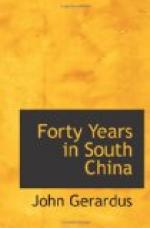“Yet he was the life of our little mission company. Do you ask why? He lived very close to God, and therefore was enabled to bow to the Divine will, to use his own language, ‘with sweet submission.’ Pohlman’s term of service, too, was short. He was called away in his thirty-seventh year. His work at Amoy was less than five years. It, too, much of it, was foundation work, though he was permitted to see the walls just beginning to rise. Two of the first converts were baptized by him, and many others received from him their early Christian instruction. The first, and still by far the best church-building at Amoy, which is also the first church building erected in China expressly for Chinese Protestant Christian worship, may be called his monument. It was specially in answer to his appeal that the money, $3,000, was contributed. It was under his supervision that the building was erected. To it he gave very much toil and care. The house was nearly ready when he took his last voyage to Hongkong, and he was hastening back to dedicate it when God took him. His real monument, however is more precious and lasting than church-buildings, as precious and lasting as the souls he was instrumental in saving, and the spiritual temple whose foundation he helped to lay. There were many who remembered him with very warm affection long after he was gone. Among them I remember one, an old junk captain, who in his later years, speaking of heaven, was wont to say, ’I shall see Teacher Pohlman there; I shall see Teacher Pohlman there.’”
V. AT THE FOOT OF THE BAMBOOS
The sad and sudden departure of Mr. Pohlman so affected a maiden sister, Miss Pohlman, then at Amoy, as to unsettle her mind and necessitate an immediate return to the United States. No lady friend could accompany her. It was decided that Mr. Talmage take passage on the same ship and act as guardian and render what assistance he could. The ship arrived at New York August 23, 1849.




